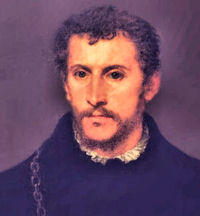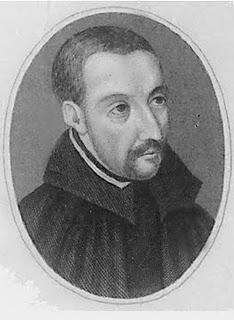Edmund was born at London in England. He was the son of a Catholic bookseller who was converted and became an Anglican. When he grew up he planned to join his father in business but received a scholarship to Saint John’s College in Oxford.

He was a very popular young English student and a very good speaker. In fact, Edmund was chosen to deliver a welcoming speech to Queen Elizabeth when she visited his college. Some students were very attracted by his happy nature and his many talents and made him their leader.
Even the queen and her chief ministers were fond of this handsome young man. The Queen wanted to make him a Deacon in the Church of England.
But Edmund was troubled about his religion, as he believed that the Catholic Church might be the only true Church. He did not hide his feelings, and the government, which was persecuting Catholics, became very distrustful of him.
Edmund knew that he would lose the queen’s favor and all his chances of a great future if he chose to become a Catholic. The young man prayed about it and decided to become a Catholic anyway.
After he had escaped from England, Edmund studied to become a priest. He entered the Society of Jesus. When the Holy Father decided to send some Jesuits to England, Father Campion was one of the first to go.
The night before he left, one of the other Jesuit priests wrote over his doorway: “Father Edmund Campion, martyr.” Although he knew what danger faced him, the holy priest set out cheerfully. In fact, he had many a laugh because of his disguise as a jewel merchant.
In England he preached with great success to Catholics who had to meet with him in secret. Spies of the queen’s men were everywhere trying to catch him. He wrote: “I won’t escape their hands much longer. Sometimes I read letters that say ‘Campion has been caught’!”
It was a traitor who finally had Edmund captured. The government officials who had been so fond of him visited Edmund in jail. Even Queen Elizabeth came.
But none of their threats or promises could make him give up the Catholic faith. Although they made him suffer, he still defended himself and his fellow priests so well that no one could answer him. But the enemies of the Church condemned him to death anyway.
Before he was put to death, St. Edmund forgave the man who had betrayed him. He even helped save the man’s life. He was tortured in the Tower of London, then hanged, drawn and quartered.
Parts of his body were displayed as a warning to other Catholics at each of the four city gates. St. Edmund Campion died in 1581.
Robert Southwell (1561-1595), one of England’s many poets but one of its most illustrious martyrs, was killed during the reign of Queen Elizabeth I. He came from a well-to-do family but had to move to the continent to study in a Catholic school.

The two Jesuits landed on a secluded coast to avoid capture in the ports of entry. Southwell was assigned to minister in and about London, living at first with the Vaux family and then in the household of the Countess of Arundel whose husband Sir Philip Howard was imprisoned in the tower for maintaining his allegiance as a Catholic. Southwell’s ministry included visiting the dozen or so prisons in the city and helping priests who had just entered the country. When Fr. Garnet, his traveling companion, also came to London, Southwell started visiting Catholics in the outlying counties. He also helped direct the print of Catholic catechisms and devotional books published by a secret press that Garnet established; it was the sole source of religious literature for English Catholics. Southwell put together several letters he had written to Sir Philip to encourage him in prison; these letters were revised and published as An Epistle of Comfort.
For six productive years Southwell exercised his ministry until he was betrayed by a Catholic woman who had been pressured into setting a trap for the Jesuit. Anne Bellamy was imprisoned after she refused to attend Protestant services and was made pregnant by Richard Topcliffe, a priest-hunter noted for torturing his prisoners. Topcliffe promised to marry her and win pardon for her family if she would convince Southwell to go a designated spot where the trap would be set. When she was released from prison, she wrote the priest asking him to meet her at her parents’ home. Southwell went there thinking she wanted to receive the sacraments. Instead Topcliffe and his men were waiting. Southwell managed to slip into a concealed room before they could catch him, but he eventually gave himself up rather than betray the family.
Topcliffe was overjoyed to have captured Southwell, whom he regarded as the biggest catch of his career. Bound in chains, the Jesuit was led to Topcliffe’s residence next to Gatehouse Prison and put in the private torture chamber that Topcliffe had there. Several excruciating days of torture failed to force Southwell to reveal a single name of any Catholics or priests. He remained steadfast despite being tortured 13 different times; finally his captors threw him among the paupers to face cold, hunger and thirst. Southwell’s father managed to visit him in the paupers’ prison and was horrified at his son’s condition. He petitioned the queen to treat him like the gentleman he was, either releasing him or condemning him to death. The queen allowed him to be moved to the Tower where he was better cared for but still could not receive visitors. He did continue, however, to write the poems that expressed his deepest feelings and were later collected and published as St. Peter’s Complaint.
For two and a half years, Southwell endured the solitude of his imprisonment, and then finally petitioned Lord Burghley to be released, be allowed visitors, or be brought to trial. The latter was granted, and he was tried on Feb. 20, 1595 at Westminster Hall. Southwell readily admitted being a Catholic priest but denied any involvement in plots against the queen. He was found guilty of high treason and executed the very next day. For the three-hour journey to Tyburn, he was tied to a hurdle and dragged through the streets to the gallows. Because the noose was improperly placed on his neck, he did not immediately die when the cart moved away from him. The hangman took mercy and hung on his feet to end the agony. Then the 34-year-old Jesuit was beheaded and quartered.
